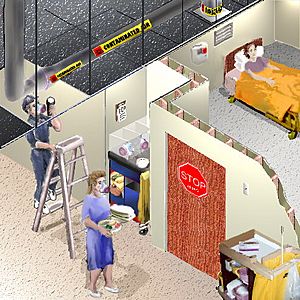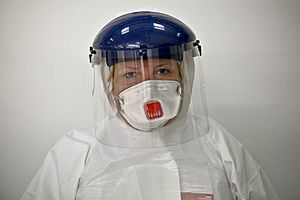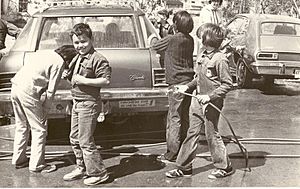Isolation (health care) facts for kids
Isolation is a way to stop germs from spreading. It is used in places like hospitals. When someone is isolated, it helps keep sick people from passing their illness to others. It also protects people who are not sick from catching germs.
There are different types of isolation. Doctors use isolation when a patient has a sickness that can easily spread. These sicknesses are often caused by viruses or bacteria.
Special tools and equipment are used for isolation. These often include personal protective equipment (PPE). PPE includes things like gowns, masks, and gloves. Hospitals also use special rooms. Some rooms have positive air pressure, and others have negative air pressure. These systems help control the air and stop germs. Some hospitals even have special isolation wards built just for this purpose.
Contents
Why Isolation is Important
Contagious diseases are illnesses that can spread easily. They can spread in different ways.
There are four main ways infectious diseases can spread:
- Contact transmission: This happens when germs spread through touch. It can be direct, like touching a sick person. It can also be indirect, like touching something a sick person has touched. Droplets from coughs or sneezes can also spread germs short distances.
- Vehicular transmission: This means germs spread through contaminated objects. An example is sharing a dirty cup.
- airborne transmission: This is when tiny germ particles float in the air. People can breathe them in and get sick.
- Vector transmission: This is when insects or animals spread germs. For example, a mosquito bite can spread a disease.
Depending on the sickness, germs can spread in many places. This includes homes, schools, workplaces, hospitals, and other public areas.
Self-Isolation
Self-isolation or home isolation means staying home on purpose. You do this to stop yourself or others from getting sick. This practice was used a lot during the 2019–20 coronavirus pandemic.
Key things to do during self-isolation are:
- Stay at home and do not go out.
- Keep away from other people in your home. Try not to be in the same room at the same time.
- Ask friends, family, or delivery services to help with errands. They can get groceries or medicines for you.
- Ask delivery drivers to leave items outside your door.
Fun Activities for Self-Isolation
Being away from school, sports, friends, and family can be tough. But keeping busy can help a lot. Here are some ideas for activities you can do inside and outside.
Outside Activities
- Do some gardening, like weeding or planting seeds.
- Find flowers to arrange in a vase.
- Collect leaves, flowers, or sticks to make a collage.
- Make leaf rubbings with different leaves.
- Go on a treasure hunt or scavenger hunt in your yard.
- Draw with chalk on pavements around your house (if allowed).
- Make shadow drawings outside.
- Find some rocks and paint them.
- Time yourself running around your backyard or house. Try to beat your best time.
- Paint the windows using shaving cream, like finger painting.
- Clean the windows!
- Play outdoor party games like an egg and spoon race.
- Have picnics in the yard.
- Wash your parents' car or your bike, scooter, or skateboard.
- Make an obstacle course.
- Build an outside fort or camp.
- Make houses in the garden for fairies.
Inside Activities
- Clean or rearrange your bedroom.
- Make cubbies and forts inside. Use cushions, sheets, couches, and pillows.
- Make some play dough.
- Press flowers inside books between baking paper.
- Make stained glass windows using different colored cellophane.
- Create your own board game.
- Make your own greeting and birthday cards to use later.
- Make some origami animals.
- Write a letter to a friend, relative, or even your teachers.
- Make paper chains to hang around your room.
- Make some paper planes. Have a contest to see which one flies the furthest.
- Try French knitting, finger knitting, or regular knitting.
- Have a disco! Hang up Christmas lights and turn off the room lights.
- Make a video diary each day. Send it to a relative or friend.
- Make a "play store" and use pantry items to sell.
(Here is a list of some traditional children's games too.)
Related pages
Images for kids
-
A traffic sign in South Carolina during the COVID-19 pandemic. It tells people to 'stay home'.
See also
 In Spanish: Aislamiento (sanidad) para niños
In Spanish: Aislamiento (sanidad) para niños









